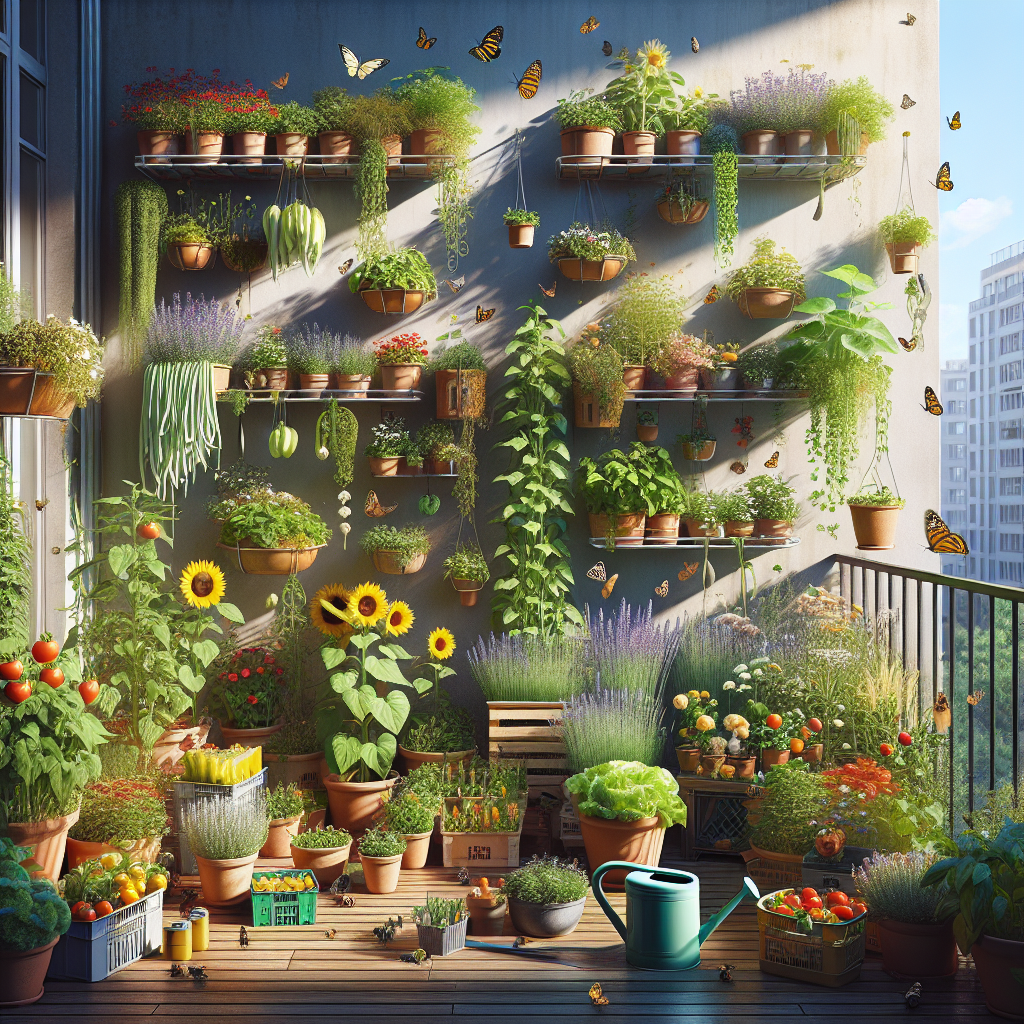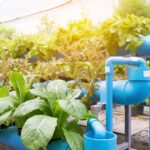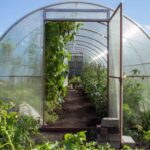
Welcome to Your Urban Oasis
Imagine your balcony as a bustling hub of nature’s busiest workers: bees and butterflies flitting from flower to flower, each plant a vibrant splash of color against the cityscape. This isn’t just a daydream; it’s a reality you can create with a handful of seeds and a sprinkle of know-how. And the best part? You’re not just beautifying your space; you’re contributing to a healthier urban environment.
Why Your Balcony Matters to Pollinators
Most importantly, your balcony garden plays a crucial role in the survival of pollinators. These tiny creatures are responsible for the reproduction of over 85% of the world’s flowering plants, including many of the fruits and vegetables we eat. But with urban sprawl and the decline of natural habitats, pollinators are struggling to find food and shelter. By planting a selection of pollinator-friendly seeds, you’re providing a much-needed oasis in the concrete jungle.
Seeds That Bring Life: A Selection Guide
Choosing the right seeds is the first step to building your pollinator paradise. But before you grab just any packet off the shelf, let’s delve into what makes a seed variety truly pollinator-friendly. We’re looking for plants that offer nectar and pollen, are rich in color and fragrance, and bloom at different times throughout the season to provide a constant food source.
Choosing the Right Seeds
When it comes to selecting seeds for your balcony garden, think about the buffet you’re setting for the bees and butterflies. Your goal is to provide a variety of tastes and textures that cater to the preferences of different pollinator species. And because space is a premium, we’re focusing on varieties that are well-suited to container gardening and can thrive in the unique conditions of an urban balcony.
Understanding Pollinator Preferences
Pollinators have preferences, just like we do. Bees, for example, are attracted to blue, purple, and yellow flowers. They also need landing platforms, like those provided by daisy-shaped blooms, and a shallow source of water. Butterflies, on the other hand, favor red, orange, and pink flowers and need full sun to bask and warm their wings. Catering to these preferences will turn your balcony into a pollinator hotspot.
- Tomatoes: With varieties like ‘Sweet Million’ and ‘Tiny Tim’, you’ll have a crop that’s as attractive to pollinators as it is delicious.
- Zucchini and Squash: The large blossoms of ‘Black Beauty’ zucchini and ‘Early Prolific Straightneck’ squash are irresistible to bees.
- Bell Peppers: ‘California Wonder’ and ‘Purple Beauty’ are not only productive but also a favorite for local pollinators.
- Cucumbers: The yellow blooms of ‘Spacemaster’ and ‘Bush Champion’ are a beacon for bees on your balcony.
- Beans: ‘Blue Lake’ bush beans and ‘Kentucky Wonder’ pole beans will have pollinators buzzing with joy.
- Herbs: Aromatic options like ‘Genovese’ basil and ‘Italian Flat Leaf’ parsley do double duty, seasoning your dishes and attracting bees.
- Peas: The delicate flowers of ‘Sugar Ann’ snap peas are a sweet treat for pollinators.
- Sunflowers: Dwarf varieties like ‘Sunspot’ and ‘Teddy Bear’ provide nectar and fit perfectly in pots.
- Zinnias: ‘California Giants’ and ‘Profusion’ zinnias bloom prolifically, offering a feast for butterflies.
Remember, a variety of plants means a variety of pollinators. By mixing these seed varieties, you’ll create a diverse buffet that welcomes all sorts of buzzing and flapping friends.
Best Seed Varieties for Bees and Butterflies
While all the plants listed above are great for attracting pollinators, let’s highlight a few stars of the show. Sunflowers, with their large, nectar-rich heads, are like the sun itself, drawing in a crowd. And zinnias, with their long blooming period, ensure that your balcony is always dressed for a pollinator party.
But don’t stop there; herbs like basil and parsley are not just for your kitchen. They flower late in the season, offering a vital food source when other blooms might be fading. And don’t forget about the humble bean plant; it’s a powerhouse for pollinators, providing both nectar and a place to rest.
Maximizing Bloom Times
To keep your balcony garden abuzz with activity, stagger your planting times and choose varieties that bloom at different intervals. This way, you’ll ensure that there’s always something in flower, providing a continuous supply of food. Early bloomers like peas and some herbs can start the season, followed by summer favorites like tomatoes and cucumbers, and then late bloomers like sunflowers and zinnias will take you through to fall.
With this strategic approach, your balcony will not just be a seasonal stopover but a year-round haven for the hardworking pollinators that keep our ecosystems thriving. And that’s something to be proud of. So let’s roll up our sleeves and get those seeds started!
Building Your Floral Haven
So, you’ve chosen your seeds and you’re ready to transform your balcony into a beacon for bees and butterflies. Here’s how to lay the groundwork for your floral haven. First, make sure you have containers with good drainage. This could be anything from traditional pots to creative upcycled items like old boots or teapots. Just remember to add holes for drainage if they’re not already there. Next, fill them with a high-quality potting mix—this will provide the right nutrients and moisture control for your plants.

Step-by-Step Planting Guidelines
Planting your seeds is a breeze. Begin by moistening the potting mix, then sprinkle your seeds on top. Cover them lightly with more mix, as most seeds need darkness to germinate. Water gently to avoid disturbing the seeds, and keep the soil consistently moist until the seedlings appear. Place your containers in a spot where they’ll get at least six hours of sunlight daily. Sunlight is like a warm hug for your plants; it’s essential for their growth and for attracting those valuable pollinators.
Remember to label your pots. It’s easy to forget what you’ve planted where, and labels can help you track your garden’s progress. Plus, they add a charming touch to your balcony décor. You can use popsicle sticks, old spoons, or even painted rocks for a natural look.
Maintenance and Care for Thriving Plants
Now that your seeds are in their cozy beds, let’s talk about care. Watering is key; do it in the morning to reduce evaporation and give your plants a full day to drink up. Be vigilant about pests and diseases; inspect your plants regularly and intervene early with organic solutions like neem oil or insecticidal soap. And as your plants grow, be sure to support them with stakes or trellises if needed—this keeps them upright and ensures they have room to show off their blooms.
Attracting a Buzz of Activity
With your plants in place, it’s time to focus on making your balcony irresistible to pollinators. Flowers are the main attraction, but there’s more you can do to ensure your winged guests have everything they need. For instance, consider adding a small dish or birdbath with clean water. Bees and butterflies need to drink, too, but they prefer shallow water sources. Add a few stones or marbles to the water so they have a place to land and sip safely.
Creating a Water Source for Your Winged Visitors
A simple water source can be as easy as a shallow dish filled with pebbles and water. This not only quenches the thirst of your pollinator pals but also adds a lovely feature to your garden. Make sure to change the water regularly to keep it clean and prevent mosquitoes from breeding.
By offering a reliable water source, you’re sending a message to bees, butterflies, and other beneficial insects that your balcony is the place to be. And when they stop by for a drink, they’ll stick around for the buffet of blooms you’ve provided.
Complementary Plants for a Diverse Ecosystem
Besides the seed varieties you’ve chosen, consider incorporating companion plants that can help attract even more pollinators. Flowers like lavender, marigolds, and nasturtiums not only add more color and variety but also bring in different types of pollinators. Plus, they can help deter pests naturally, keeping your garden healthy and thriving.
Seasonal Considerations and Year-Round Care
As the seasons change, so will the needs of your balcony garden. In the spring and summer, focus on providing plenty of water and watching for pests. As autumn approaches, allow some plants to go to seed; these seeds will provide food for birds and can self-sow for the next year. When winter arrives, protect your perennial plants with mulch or bring them indoors if possible. This helps ensure they’ll be ready to burst back into life when spring comes around again.
Preparing for Changing Seasons
As summer fades to fall, don’t be too quick to clear away spent blooms. Many pollinators are still active and looking for food, and those seemingly spent flowers might just be their last feast before the cold sets in. When you do tidy up, leave the roots of annuals in the soil. They’ll decompose and enrich the soil for next year’s plants. And when you’re choosing seeds for the upcoming season, always think about what will thrive in the current and upcoming conditions.
Year-Round Pollinator Activities
Even in the off-season, you can support pollinators. Consider setting up a small insect hotel to offer shelter to solitary bees and other beneficial insects. You can also leave out bits of sponge soaked in sugar water as an emergency food source during early spring or late fall when natural nectar sources are scarce.
Celebrating Success: Your Living Balcony
Once your balcony garden is blooming and buzzing with life, take a moment to appreciate the vibrant ecosystem you’ve created. Your efforts have not only beautified your home but have also provided a sanctuary for pollinators in need. Share your success with friends and neighbors, and inspire them to start their own pollinator-friendly spaces. The more habitats we create, the stronger our urban pollinator populations will become.
Showcase Your Green Thumb to the Neighborhood
Don’t keep your green thumb a secret. Showcase your blooming balcony to the neighborhood. Take photos and share them on social media, or invite friends over for a garden tour. The more we spread the word about the importance of pollinator-friendly spaces, the more we can all contribute to a healthier, greener urban environment.
And remember, every plant counts. Each flower you grow is a step towards a better future for our pollinators and our planet. So, let’s get started and turn those balconies into bountiful havens of life and color!
For those ready to embark on this rewarding journey, Survival Essentials offers a variety of heirloom seeds that can help you create a thriving pollinator-friendly garden. Their selection of non-GMO, high-quality seeds is perfect for urban gardeners looking to make a difference.
Even in the off-season, you can support pollinators. Consider setting up a small insect hotel to offer shelter to solitary bees and other beneficial insects. You can also leave out bits of sponge soaked in sugar water as an emergency food source during early spring or late fall when natural nectar sources are scarce.
Frequently Asked Questions
What Are the Best Plants for Attracting Bees and Butterflies?
The best plants for attracting bees and butterflies are those that provide nectar and pollen. Some top choices include sunflowers, zinnias, lavender, marigolds, basil, parsley, tomatoes, zucchini, squash, bell peppers, cucumbers, beans, and peas. Opt for varieties that thrive in containers and have different blooming periods to provide a continuous food source.
How Do I Maintain a Pollinator-Friendly Balcony in Limited Space?
To maintain a pollinator-friendly balcony in limited space, choose compact plant varieties and use vertical space by adding hanging baskets and trellises. Regularly check for pests, water appropriately, and provide a water source for pollinators. Rotate plants seasonally to ensure year-round blooms.
Can I Create a Pollinator Habitat in a Shaded Balcony?
Yes, you can create a pollinator habitat in a shaded balcony by selecting shade-tolerant plants that still attract pollinators. Some options include impatiens, foxgloves, and ferns. Be sure to include a water source and consider adding a small light to mimic sunlight for certain periods of the day.
What Pesticides Should I Avoid to Protect Pollinators?
To protect pollinators, avoid using pesticides that are known to be harmful to bees and butterflies, such as neonicotinoids and pyrethroids. Opt for organic pest control methods like neem oil, insecticidal soaps, or encouraging natural predators like ladybugs.






